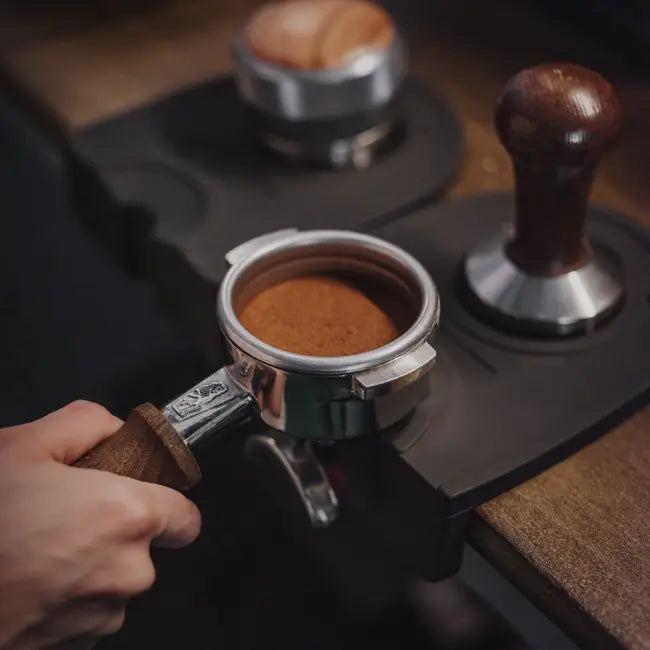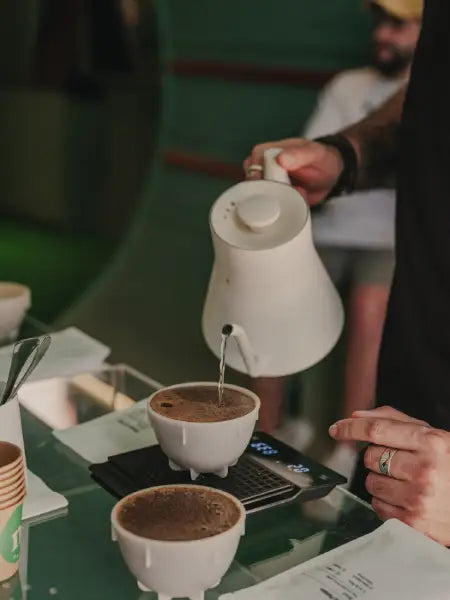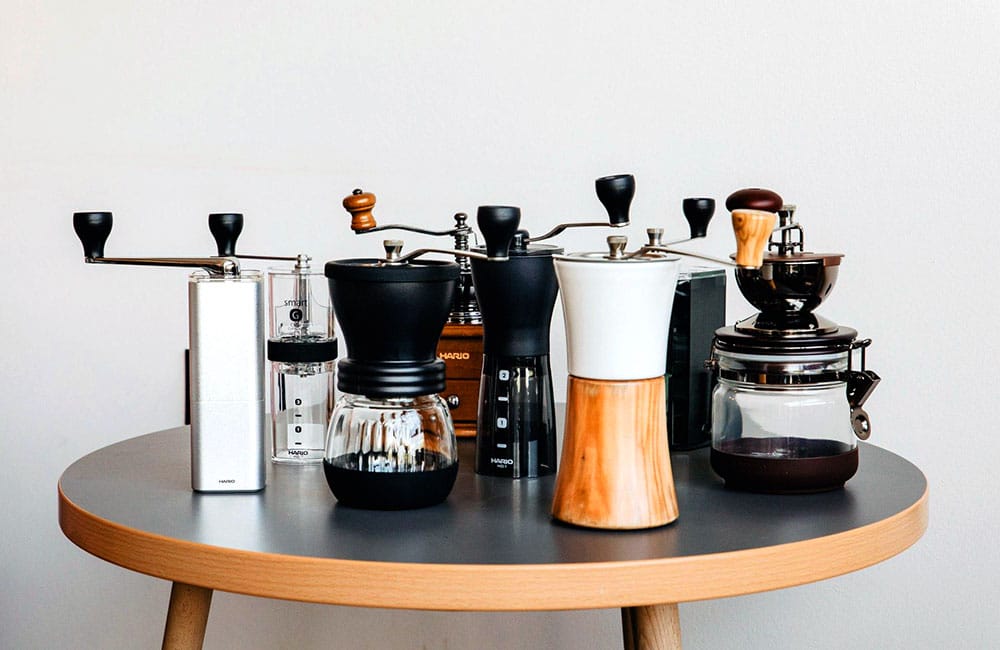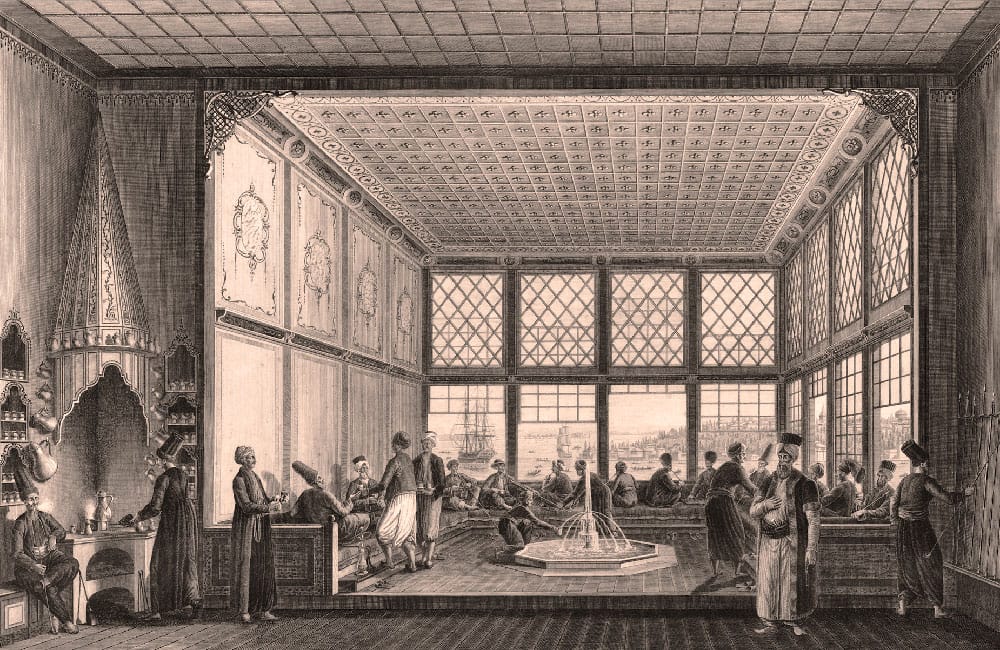Coffee Grinders
The Gilgamesh poem, whose composition is dated around 2500 BC., is the oldest epic narrative and one of the earliest examples of literary fiction.In one of its parts, the hero, Gilgamesh, plunges into the depths of the Persian Gulf to search for the "flower of immortality". These are the pearls found inside the oysters.
Something similar happens with coffee. Each seed is like a pearl that is hidden inside the berry; and inside each seed a world of tasting notes and physiological experiences when caffeine stimulates our nervous system.
To get the treasure that each coffee bean hides, we have to cultivate the berries, obtain and process the seeds and then brew them. And for a correct brewing we have to grind the coffee. For this we will need a coffee grinder.
Coffee grinders are an essential tool if we want to obtain the flower of immortality that each coffee bean hides; although that immortality might be temporary.
Why do We Need a Coffee Grinder?

Parts of a coffee grinder
This question may seem obvious, but it really isn't. We could rephrase it this way: why do we need a coffee grinder when we can buy ground coffee?The answer is simple. We need a coffee grinder if we want to maintain the organoleptic qualities of the coffee until brewing.
Coffee is an organic substance and, like all of them, subject to an oxidation process due to being in contact with oxygen (in this post we explain in detail the coffee oxidation process and how to slow it down).
The greater the area of contact with oxygen, the greater the degree of oxidation. Therefore, by keeping the coffee in beans we are reducing the contact surface and delaying oxidation.
The Coffee Oxidation Process
 Coffee cherries in the plant
The coffee begins oxidising from the moment the berries are taken from the coffee trees. But while the coffee is green, its natural chemical compounds have not been altered and it oxidates less.
Coffee cherries in the plant
The coffee begins oxidising from the moment the berries are taken from the coffee trees. But while the coffee is green, its natural chemical compounds have not been altered and it oxidates less.Once the coffee has been roasted, the heat causes these natural chemicals to alter and release gases. This gives us the drink we love so much, but it also speeds up the process.
For this reason, it is important to keep the coffee beans whole until just before brewing. Being whole, the coffee has less contact surface with oxygen than if it was ground. By having less surface, there is less oxidation, and therefore there is less loss of tasting qualities.
In addition to keeping the coffee beans whole, another important way to slow down coffee oxidation is the correct packaging.
As we have said, when coffee is roasted it releases CO2 as a result of a natural chemical reaction. These gases continue to emerge after roasting is complete.
A proper packaging is in a hermetically sealed bag, but with a one-way valve. This way, the gases that the coffee continues to release can push out the remaining oxygen from the bag through the valve and slow down oxidation.
What is a Manual Coffee Grinder?
Another question that may seem obvious, but it is not. A manual coffee grinder is a tool that allows us to reduce the size of the coffee beans to a smaller size so that the water can extract all their properties.So far so good, but by this definition any tool that gives us the same results could be considered a grinder. And in a way it is. Some of us have come to grind coffee with two river stones in the absence of one.
But not all grinders are the same.
 Two river stones used as a coffee grinder
Two river stones used as a coffee grinderManual or Electric Coffee Grinder?
When we refer to a manual coffee grinder, we are talking about a tool designed to grind coffee by hand. These two points are important: grind and by hand. Because we could think, so what about an electric grinder? It could be an option, but only if you have enough budget.Everyday electric grinders will not grind your coffee, they will crush it, and since they are powered by a motor, they can heat the coffee. We should avoid both. By crushing it, the resulting particles will be of very different sizes (we will see later why this is not good, but it has to do with the extraction theory) and the heat can cause it to lose qualities.
Hand grinders - especially those designed to grind coffee - often have conical burrs that help grind more evenly. And, since they work by hand, you are the engine so it does not heat up (although this might create a curious paradox: you need caffeine to grind, but you need to grind to get caffeine. We have solved it and we propose a solution further in the article).
 Different brew methods to prepare coffee
Different brew methods to prepare coffee
Extraction Theory
Now let's focus briefly on the extraction theory. The extraction theory refers to how we carry out the extraction of solubles from coffee when they come into contact with water. Also to the amount of solubles that said extraction must contain. Obviously, for this to happen, we must grind the coffee.The coffee beverage is the result of extracting with water the soluble particles contained in each coffee bean. Coffee has about 28% organic and inorganic matter that, once roasted and ground, dissolves in water. The remaining 72% is cellulose from the seed fibre and will not dissolve under normal conditions (and we don't want it to dissolve).
This 28% is made up of about 800-1000 natural flavours and aromas. These different compounds, which vary from coffee to coffee, is what gives each cup so much complexity and what differentiates one coffee from another.
Of this 28% of solubles, for a correct extraction, we must try that between 18% and 22% dissolve correctly in the water. If it is more than this, we may end up with an over extracted cup and bitter notes. If it is less than 18%, we may end up with an under extracted cup and we won’t get all the possible organoleptic notes.
The vanguard of specialty coffee is experimenting with up to 27% extraction, but to achieve acceptable results with this percentage we must have a very clear idea of what we are doing and what we want to achieve.
Theory of extraction and grind size distribution
 Approximate difference between grind sizes
It is obvious that to obtain these percentages the coffee must be ground. If it were in whole beans, this would not be possible since the water would not penetrate enough into the coffee to carry out a correct brewing.
Approximate difference between grind sizes
It is obvious that to obtain these percentages the coffee must be ground. If it were in whole beans, this would not be possible since the water would not penetrate enough into the coffee to carry out a correct brewing.When grinding the coffee, what we are looking for is that all ground particles have a size as similar as possible. If this was not the case, if some ground particles were very large and others very small, there would be parts over-extracted and others under-extracted. This would result in a cup with bitter notes and watered down at the same time.
The way to check that our grind is correct is by measuring the grind size distribution of coffee particles. These will vary from one micron to fifteen hundred microns.
But these are the extremes, most will be between 100 and 800 microns. Our goal when grinding is for all particles to fall within these ranges and be as similar as possible.
This is the function of a good manual coffee grinder. It can also be achieved with an electric one, but probably at a much higher cost.
Enjoy seasonal coffee, visit our shop
How does grind size distribution affect coffee extraction?
This video explains in a very clear way how the different particle size affects the extraction. An experiment is carried out in the video to see how water penetrates coffee particles depending on their size.First, the coffee is ground and with several strainers the ground particles are separated by microns:
- Those from 0 to 250 microns
- Those from 250 to 500 microns
- Those greater than 500 microns
Then the coffee is brewed by immersion, left to sit and measurements taken in time fractions to see the percentage dissolved.
The result is that in particles from 0 to 500 microns, a complete extraction of all solubles might be achieved with enough time. But in those greater than 500 the water does not penetrate completely, so a complete extraction is not possible. The following image illustrates it easily.
 In the image, the dark brown colour represents coffee particles and the light brown colour represents how far water penetrates. As we can see, in the larger particles (>500 microns) the coffee does not penetrate to the centre and therefore a complete extraction is not carried out.
In the image, the dark brown colour represents coffee particles and the light brown colour represents how far water penetrates. As we can see, in the larger particles (>500 microns) the coffee does not penetrate to the centre and therefore a complete extraction is not carried out.
Equip yourself with our accessories, go to the shop
How to use a coffee grinder?
Any coffee grinder worth its name will have a way to adjust the grind size, whether it's a manual or electric grinder.This is the most important thing when grinding coffee: that we adjust the grinding to the brewing method that we are going to use and that the grinding is as homogeneous as possible.
And this is what differentiates a good coffee grinder from a bad one: adjustability and grinding homogeneity.
To achieve this, grinders that are designed for specialty coffee usually have conical burrs made of ceramic or steel. They will also have a mechanism to adjust the size of the grind.
All the grinders that we propose below have at least these two characteristics, and others that will also be very useful to you. And, as a first reference for correct grinding according to the extraction method, you can follow this guide:
- Espresso: very fine grinding (almost like flour)
- Mokka: finely ground (like fine salt)
- AeroPress: medium grind (slightly coarser than fine salt)
- V60: medium grind (a little coarser than fine salt)
- Chemex: medium grind (a little coarser than fine salt)
- Plunger: coarse grinding (like coarse salt)
The best coffee grinders in 2022
We present to you four coffee grinders that meet all the characteristics that we have described above. Three of them are manual and one is electric. These grinders are in a range of different prices so you may choose the one that best suits your budget, but they will all give you satisfying results (we've tested them!)- Comandante Hand Grinder: this grinder is the star of hand coffee grinders
- Timemore C2 Hand Coffee Grinder: the best value for money
- Hand Grinder Hario Mini Mill: for those with a tight budget, but without sacrificing the essentials
- Wilfa Svart Aroma Precision Electric Coffee Grinder: The best if you want to solve the 'I need caffeine to grind, but I need to grind to get caffeine' paradox.
Comandante C40 Hand Coffee Grinder: The Star of Hand Grinders
 Comandante Hand Grinder C40
This grinder has been designed to meet the highest expectations of all specialty coffee lovers.
Comandante Hand Grinder C40
This grinder has been designed to meet the highest expectations of all specialty coffee lovers.This brand has put a lot of research into it. As a result, it has an advanced design and material in its conical burr wheels. This means that the wheels do not wear out over time and maintain uniform grinding time after time.
In addition, the rest of the parts, both the body, the shaft and the crank are made of stainless steel.
The bearings are micro balls and are made of the same material as the grinding wheels: martensitic stainless steel. This steel has a high nitrogen content that makes it very resistant.
The body has wooden details, both on the lid and on the handle, from Black Forest oaks.
The container for the ground coffee is made of high resistance glass.
It has an easy adjustment system for any type of brewing, from espresso to french press.
This grinder is stylish, useful and highly durable. It is a high but safe investment. If you don't lose it, you probably won't need another one.
 Timemore Chestnut C2 Manual Grinder
Timemore Chestnut C2 Manual GrinderTimemore C2 coffee grinder: the best value for money
This grinder is a recent addition from a brand that is doing things very well in the coffee world.Its base is made of conical 5-blade stainless steel burrs. This ensures a homogeneous grinding for a longer time.
The exterior is made of rugged aluminium, which makes it very resistant as well as giving it a contemporary style.
Unlike the previous one, it has some elements inside, such as the shaft, which are made of highly resistant plastic. But they are elements that are protected from blows and are not at risk of breaking.
It has a large crank to facilitate moving the burrs so that you have to make less effort.
It is a beautiful grinder that you can easily disassemble and take anywhere and that ensures a homogeneous grind. It is also easily adjustable for any brewing method
It has all the characteristics that we would ask of a specialty coffee grinder. It is a safe bet for a cheaper price and one that will not disappoint you in its use or durability.
Hario Mini Mill coffee grinder: a grinder for everyone
 Hand Grinder HARIO Mini Mill
This is the grinder that we recommend to everyone who is new to the world of specialty coffee. It's good, it's nice and it's cheap.
Hand Grinder HARIO Mini Mill
This is the grinder that we recommend to everyone who is new to the world of specialty coffee. It's good, it's nice and it's cheap.It is built around conical ceramic burrs that ensure a homogeneous grinding for a longer time. And this is the most important thing in a grinder.
Everything else except the crank and axle, which are made of aluminium, is plastic. But this does not mean that it is of poor quality. It is well designed and manufactured. It is beautiful and can be easily disassembled for transport and cleaning. And of course, the grind is adjustable.
So why is its price so much lower than the previous ones? Well, because other than its wheels, money has been saved with the rest of materials used.
And this is noticeable. We have heard that both, the part that contains the coffee beans and the container for when it is ground, have a tendency to break if they suffer a strong blow.
But for its price, we do not see this as an inconvenience, rather something to be expected. We simply have to be more careful, because we have also had some which have lasted us for years.
Wilfa Svart electric coffee grinder
 Wilfa Svart electric coffee grinder
The answer to our paradox. The one that said, “I need caffeine to grind coffee, but I have to grind coffee to get caffeine”.
Wilfa Svart electric coffee grinder
The answer to our paradox. The one that said, “I need caffeine to grind coffee, but I have to grind coffee to get caffeine”.If you want a home coffee grinder this is a great option. It has conical stainless-steel burrs and the size of the grind is adjustable in a very easy way. The motor it uses is tuned to maximise its efficiency and it generates virtually no heat.
It also has a timer that you can set and a large load capacity (up to 250 grams). Although we do not recommend that you load more than the coffee you are going to use each time, so that it does not oxidise and lose organoleptic qualities.
It is made of black polycarbonate and it is elegant. The only but is that you will not be able to take it anywhere, because it is relatively large compared to manual grinders.
In regards to its price, it is a considerable but not exaggerated investment that is worth it if what you want is an electric grinder for your home.
Choose your weapon
Now that you know the importance of correct grinding and you know the difference between an electric grinder and a hand one -and when to choose one or the other- the question is very simple...Which one do you prefer?









